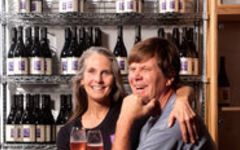Flying Goat Cellars Goat Bubbles Blanc de Blancs 2012



Product Details
Your Rating
Somm Note
Winemaker Notes
Other Vintages
2013-
Wine
Enthusiast


Two pygmy goats, Never and Epernay, inspired Norm to name his winery Flying Goat Cellars. The goats were his pets and lawnmowers and came to be a source of entertainment and enjoyment, with their unrestrained spiral loops, flipper turns and straight-legged leaps. When pondering a name for his new wines and brand, Norm wanted to project fun, enjoyment, and happiness. While many people put their own name or their children’s name on their label or vineyard, Norm’s playful spirit opted to name it after his kids. His kids, of course, were those two pygmy goat pets, who had always inspired him and made him laugh.
Norm shared his passion with Kate Griffith by courting her with his first release of Goat Bubbles in 2006. We don’t know if it was the bubbles or the winemaker's charm but it culminated in a marriage and a family of wines.
Now Flying Goat Cellars produces about 2,500 cases a year and includes three labels: Flying Goat, Goat Bubbles and YNOT. Flying Goat focuses on vineyard designated Pinot Noirs and Pinot Gris. Goat Bubbles offers four vineyard designated sparkling wines: Rosé, Blanc de Blancs, Blanc de Noirs, and Crémant, all made in the traditional méthode champenoise with the secondary fermentation in the bottle. YNOT is Pinot Noir blended from the finest of Santa Barbara County vineyards.

Representing the topmost expression of a Champagne house, a vintage Champagne is one made from the produce of a single, superior harvest year. Vintage Champagnes account for a mere 5% of total Champagne production and are produced about three times in a decade. Champagne is typically made as a blend of multiple years in order to preserve the house style; these will have non-vintage, or simply, NV on the label. The term, "vintage," as it applies to all wine, simply means a single harvest year.

A lesser-known but elite AVA within the larger Santa Barbara district, the Santa Maria Valley AVA runs precisely west to east starting near the coast. The valley funnels cool, Pacific Ocean air to the vineyards more inland, allowing grapes a longer hang time to ripen evenly and achieve their full potential by harvest time. Combined with minimal rainfall, consistent warm sunshine, and well-drained soils, it is an ideal environment for grape growing.
Many of the wineries here are small and highly respected, having established a reputation in the 1970s and 80s for producing excellent Central Coast wines like Pinot Noir and Chardonnay. More recently, Syrah has also proven quite successful in the region. Many vineyards are owned by growers who sell their grapes to other wineries, so it is common to see the same vineyard name on bottlings from different wineries. Bien Nacido Vineyard is perhaps the best-known and most prestigious.
